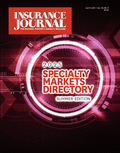Second quarter 2025 net income at Cincinnati Financial Corp. was $685 million鈥攎ore than double the $312 million in net income booked a year ago during the same time.
“It was a solid quarter, showing the strength of our agent-centered strategy and the value of our long-term plans to steadily expand product and geographic diversification as well as deepen pricing segmentation and sophistication,” Stephen M. Spray, president and chief executive officer, said in a statement.
The company’s insurance operations turned in a Q2 combined ratio of 94.9, an improvement from 98.5 in Q2 2024. For the first half of 2025, the combined ratio was 103.8 versus 96.1 for the first six months of 2024.
 Net written premiums (NWP) at Cincinnati were up 11%鈥攊ncluding price increases, premium growth initiatives and a higher level of insured exposures鈥攄uring both Q2 and the first half. At the half-way point, NWP stood at about $5.2 billion, which is the first time NWP has eclipsed the $5 billion threshold, according to Spray.
Net written premiums (NWP) at Cincinnati were up 11%鈥攊ncluding price increases, premium growth initiatives and a higher level of insured exposures鈥攄uring both Q2 and the first half. At the half-way point, NWP stood at about $5.2 billion, which is the first time NWP has eclipsed the $5 billion threshold, according to Spray.
Renewal premiums from business written by agencies were up 16% in Q2 to about $2.1 billion. New business premiums from agencies were down slightly to $404 million compared to $407 million for Q2 2024.
Cincinnati said 258 new agency appointments were made in the first half of the year, including 47 that market only the insurer’s personal lines products.
The personal lines insurance segment booked a Q2 underwriting loss of $14 million compared to a loss of $42 a year ago. The underwriting loss stands at $371 million for this business after six months. The combined ratio here was 102 for the quarter, an improvement from 106.9 for Q2 last year, but the combined ratio for the first half in personal lines was 124.9 compared to 11.6 a year ago.
Cincinnati said NWP for its high-net-worth product grew 25% to $529 million in Q2.
Results for commercial lines business were more favorable, with Q2 underwriting profit of $87 million compared to $10 million a year ago. The combined ratio improved 6.2 points to 92.9.
“Keeping underwriting discipline in mind, we’ve managed average commercial lines price increases near the high end of the mid-single-digit percent range and excess and surplus lines in the high-single-digit percentage range,” reported Spray. “Personal lines homeowner prices increased on average in the low-double digit percent range and auto in the high-single-digit percent range.”
Topics Profit Loss
Was this article valuable?
Here are more articles you may enjoy.


 Florida Regulators Say They Need More Authority to Rein in Slide’s Exec Pay
Florida Regulators Say They Need More Authority to Rein in Slide’s Exec Pay  Chubb Q2 Net Income Jumps 33% on Premium Growth, Underwriting
Chubb Q2 Net Income Jumps 33% on Premium Growth, Underwriting  Uber Alleges Inflated Injury Bills in Los Angeles Insurance Fraud Lawsuit
Uber Alleges Inflated Injury Bills in Los Angeles Insurance Fraud Lawsuit  Tally of Microsoft Victims Surges to 400 as Hackers Exploit SharePoint Flaw
Tally of Microsoft Victims Surges to 400 as Hackers Exploit SharePoint Flaw 


